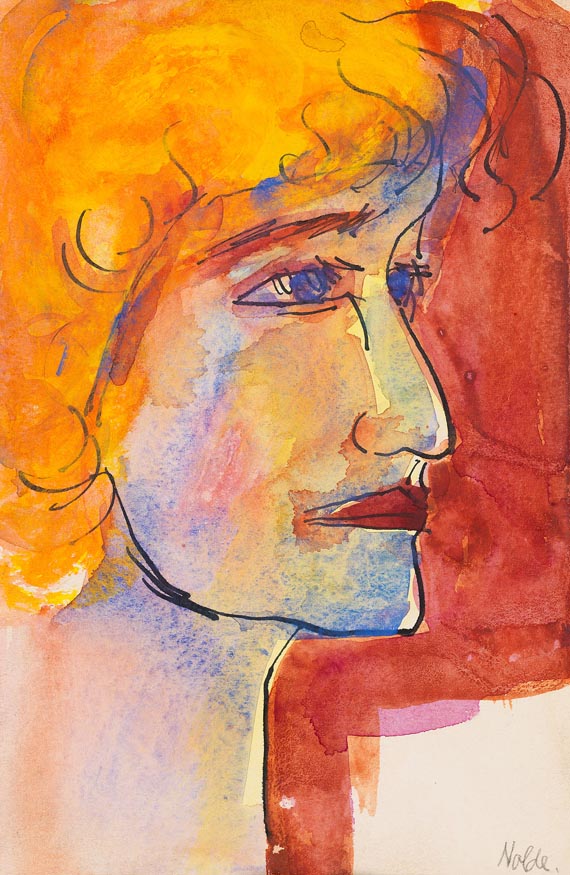
53.10
Emil Nolde
Frauenkopf im Halbprofil nach rechts, 1916.
Watercolour
Estimate:
€ 25,000 / $ 26,750 Sold:
€ 61,000 / $ 65,270 (incl. surcharge)
Watercolor and gouache over India ink drawing
Signed lower right. On firm laid paper. 23,3 x 15,4 cm (9,1 x 6 in), the full sheet
This work is accompanied by a photo expertise by Dr. Manfred Reuther, Foundation Seebüll Ada and Emil Nolde, dated 16 May 2010.
PROVENANCE: Private collection southern Germany.
Emil Hansen was born near the German-Danish border on 7 August 1867. He adopted the name of his birth town as his artist name at a later date. Nolde completed an apprenticeship as a furniture designer and wood carver in Flensburg between 1884 and 1888 and then worked for various furniture factories in Munich, Karlsruhe and Berlin. He was employed as a teacher of industrial drawing at the Gewerbemuseum (Industrial Museum) in St. Gallen in 1892, where he taught until 1898. There, where at first mainly landscape watercolors and drawings of mountain farmers emerged, Nolde became known through small colored drawings of Swiss mountains. He joined Adolf Hölzel in Dachau to become his pupil and went to Paris in 1899 to increase his knowledge at the Académie Julien. In 1900 Nolde rented a studio in Copenhagen and moved to the island of Alsen in 1903. He studied the Neo-Impressionists Vincent van Gogh, Edvard Munch and James Ensor, which, around 1905, gradually led him away from his early Romantic Naturalism and to the discovery of his own style with a strong emphasis on color, colorful and glowing flower pictures came into existence. During a sojourn in Alsen in 1906 Nolde met the painters of 'Die Brücke', a group he joined briefly in the same year. A series of portrait studies marked the artists discovery of the watercolor. Nolde's first attempts in 1909 at painting in this technique on non-absorbent paper, leaving large areas of the paper uncovered and dispensing with contours, were quite revolutionary. After a dispute with Max Liebermann, Nolde was excluded from the Berlin Secession and founded, together with other dismissed artists, the 'New Secession' in 1910 and participated in their exhibition until 1912. He returned from an expedition to New Guinea in 1913 with lots of study material, which he worked up in numerous works until 1915. Since 1916, he spent his summers on the island Föhr and settled in Seebüll in 1928.
It is not the individual expression of the depicted person, but rather the overall expression that guided Nolde. The energetic statement that dominates this portrait becomes most obvious on the chin. It matches the sitters personality, which clearly seems to have impressed Nolde. The subtle coloring that Nolde chose to underline a character trait consciously does without narrative details and emphasizes an overall impression that is enhanced by varying wash colors.
Defamed during the war and imposed with an ocupational ban by the Nationa Socialists in 1941, Nolde spent the years 1939 to 1945 in Seebüll painting his 'unpainted paintings', several hundred small watercolors, which he took on in his oil paintings after 1945. In his last years, primarily watercolors with flower and landscape motifs from the neighborhood of his house in Seebüll, where Nolde died on 13 April 1956, came into existence. [KD].
53.10
Emil Nolde
Frauenkopf im Halbprofil nach rechts, 1916.
Watercolour
Estimate:
€ 25,000 / $ 26,750 Sold:
€ 61,000 / $ 65,270 (incl. surcharge)




 Lot 53.10
Lot 53.10 